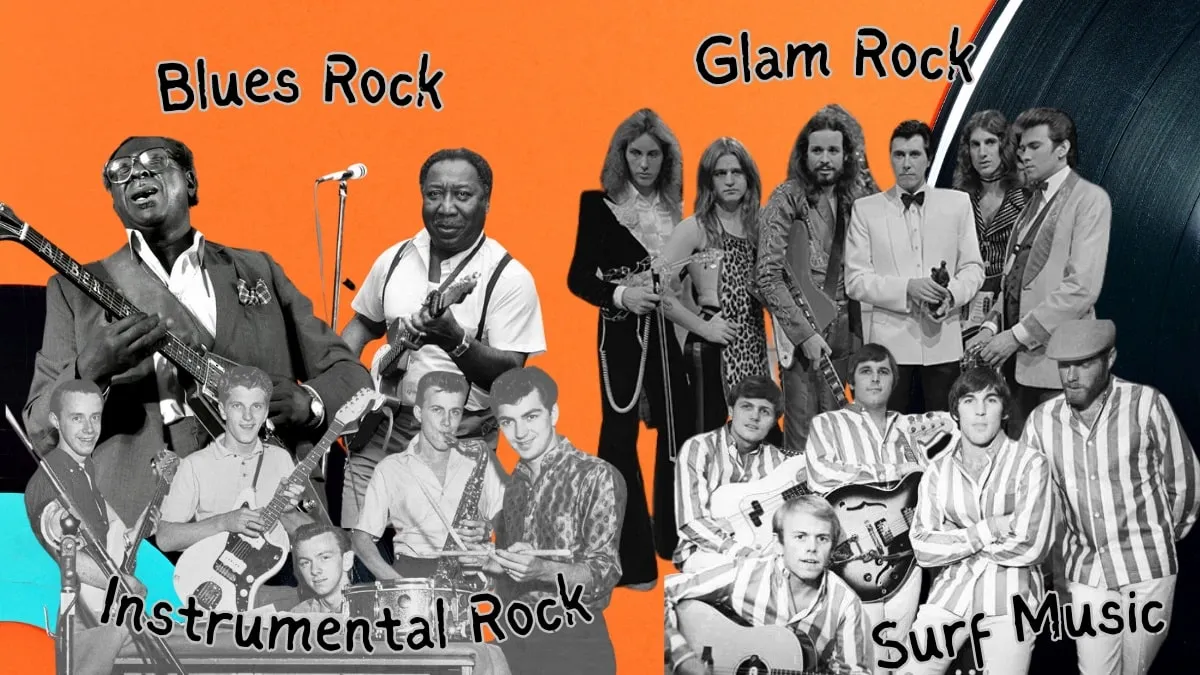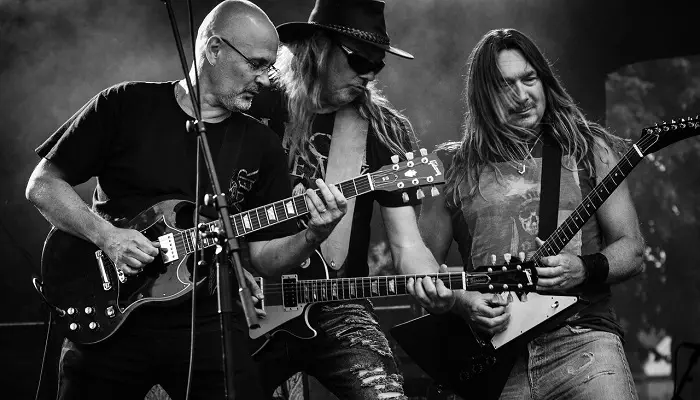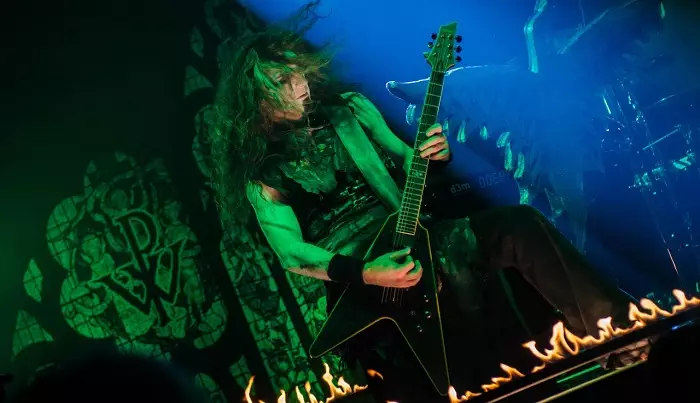Rock music is a popular music genre that began as “rock and roll” in the United States in the 1940s and early 1950s. It evolved into several different styles in the mid-1960s and later, especially in the United States and the United Kingdom.
Its style derives extensively from the styles of blues, rhythm and blues, and country music. For instrumentation, rock is based on the electric guitar, usually as part of a rock band with electric bass, percussion, and one or more singers.
By the late 1960s, a variety of distinct subgenres of rock music had developed, including hybrids such as blues-rock, folk-rock, country-rock, southern rock, raga rock, and jazz-rock, all of which led to the development of psychedelic rock, which was inspired by the countercultural psychedelic and hippie scene.
The new genres that emerged included progressive rock, which expanded artistic features, glam rock, which highlighted showmanship and visual style, and the diverse and lasting subgenre of heavy metal, which stressed volume, power, and speed. In the second half of the 1970s, punk rock responded by generating up-and-down, energetic social and political critique.
In the 1980s, Punk influenced new wave, post-punk, and ultimately alternative rock. From the 1990s, progressive rock started to overtake rock music and enter into popular music in grunge, Britpop, and indie rock.
Since then, more fusion subgenres have developed, including pop-punk, electronic rock, rap rock, and rap metal, and deliberate efforts to revive the past of rock, including garage rock/post-punk and techno-pop revivals in the early 2000s. The late 2000s and 2010s saw a great fall in mainstream rock music prominence and cultural importance, with hip-hop surpassing it as the most popular genre in the United States.
Rock music has both embodied and acted as a platform for artistic and social movements, contributing to significant subcultures, including mods and rockers in the UK and hippie counterculture. Similarly, the punk culture of the 1970s spawned subcultures of goth, punk, and emo.
Inheriting the folk heritage of protest song, rock music has been synonymous with political activism and shifts in societal views against race, sex and drug use. It is also used as an example of youth revolt towards adult consumerism conformity. It has been very profitable financially.
Origin
The origins of rock and roll remain a point of controversy with historians. The consensus is that it started in the United States’ southern parts, where the most famous rock and roll artists began to appear. It was created by a mixture of influences, such as classical African music and European instrumentation.
Characteristics of Rock Music
- The sound of rock is historically based on the amplified electric guitar that appeared in its current form in the 1950s with rock and roll popularity.
- The sounds of electric blues guitarists also inspired it.
- The electric guitar sound in rock music is generally accompanied by the electric bass guitar, a pioneer of jazz music of the same era, and the percussion created by a drum kit that incorporates drums and cymbals.
- This trio of instruments has also been complemented by incorporating other instruments, specifical keyboards such as the piano and the synthesizer.
- The simple rock instrumentation was born from the basic blues band instrumentation.
- A group of musicians playing rock music is referred to as a rock band. Also, it normally consists of between three (the Power Trio) to five members.
- A rock band takes the form of a quartet whose members cover one or more positions, including a vocalist, lead guitarist, rhythm guitarist, bass guitarist, drummer, and sometimes a keyboard player or other instrumentalist.
Types of Rock Music
The various types of rock music are as follows:
Instrumental rock
Instrumental rock is a rock genre that emphasizes instrumentals and features little or no singing at all. Instrumental rock was the most popular between the mid-1950s and mid-1960s, with musicians such as Bill Doggett Combo, The Fireballs, The Shadows, The Ventures, Johnny and the Hurricanes, and The Spotnicks.
Many instrumental hits have come from the world of R&B. In the 1970s, funk and disco produced many instrumental hit singles. The Allman Brothers Band has a variety of instrumentals.
In the 1970s, Jeff Beck released two instrumental albums. Progressive rock and art rock artists performed a variety of virtuosic performances in the 1960s and 1970s.
In the 1980s and 1990s, the instrumental rock genre was dominated by many guitar soloists, including Joe Satriani, Yngwie Malmsteen and Steve Vai. The 2000s have given way to a modern form of instrumental artist.
Pop-Rock
Pop-rock is rock music focusing on technical songwriting and and less emphasis on attitude. Originating in the late 1950s as an alternative to normal rock and roll, the early pop-rock was inspired by the rhythm, the structure, and the original form of rock and roll.
It should be seen as a separate genre rather than music that overlaps with pop and rock. Pop-rock reviewers also deride it as a slick commercial offering, less genuine than rock music.
Most pop and rock music was very similar in sound, instrumentation, and even lyrical content. The words “pop-rock” and “power pop” have been used to describe more commercially popular music that uses elements of rock music.
Latin Rock
Latin rock is a term used to describe a subgenre in music composed of the melting of popular sounds and Latin American and Caribbean folk elements with rock music. However, any form of rock music featuring Spanish or Portuguese vocals is commonly used in English-language media. This leads to a disagreement about the scope of the language.
Latin rock should not be confused with “rock music from Latin America” or rock in Espanola. It is closely related to the Latin alternative scene, which sometimes refers to the same phenomenon.
Surf Music
The instrumental rock and roll of musicians, such as Duane Eddy, Link Wray and Ventures, was produced by Dick Dale, who incorporated distinctive “wet” reverb (fast alternative selection), and Middle Eastern and Mexican influences. He produced the regional hit “Let’s Go Trippin'” in 1961 and started the surf music craze, followed by songs like “Misirlou” (1962).
Surf music has experienced its greatest commercial popularity as vocal music, especially the Beach Boys’ work, born in 1961 in southern California. Their early recordings featured instrumental surf rock and vocal tracks, rock and roll and doo-wop illustrations, and the close harmonies of vocal pop groups like the Four Freshmen.
The Beach Boys first chart hit, “Surfin'” reached the Billboard Top 100 in 1962 and helped make surf music a national phenomenon. It is often claimed that the surf music craze and virtually all surfing artists’ fortunes had essentially ended with the advent of the British Invasion in 1964 because most of the surf music hits were recorded and released between 1961 and 1965.
British Invasion
Cliff Richard got the first British rock and roll success with “Move It,” an effective start to the sound of British rock. At the beginning of the 1960s, his Shadows support group was the most active instrumental recording group. As rock ‘n’ roll faded into lightweight pop and ballads, British rock bands in clubs and local dances started to perform with passion and drive rarely seen in American acts.
Garage Rock
Garage Rock is a raw and energetic rock and roll style that flourished in the mid-1960s, most notably in the United States and Canada, and has endured several subsequent revivals. Simple chord structures distinguish the style played on electric guitars and other instruments, often distorted by a fuzzbox. Its name comes from the belief that groups were mostly made up of young amateurs who rehearsed in the family garage.
In the 1960s, garage rock was not known as a distinct genre and had no clear name. Still, the critical hindsight of the early 1970s—and particularly the 1972 compilation album Nuggets—did a lot to identify and memorize the style.
Between 1971 and 1973, some American rock writers started to classify music as a genre retroactively and, for many years, used the word “punk rock” to describe it, making it the first style of music to bear the definition, predating the more familiar usage of the term appropriated by the later punk rock movement that it inspired.
In the 1980s, the term “garage rock” gained popularity among critics and devotees. The style was often referred to as “proto-punk” or “frat rock” in some cases.
Blues Rock
Blues rock is a mixed genre that incorporates the characteristics of blues and rock. It’s mostly electronic ensemble-style music with instrumentation close to electric blues and rock: electric guitar, electric bass guitar, and drums, often with keyboards and harmonics.
Since its roots in the early to mid-1960s, blues music has experienced a range of stylistic changes and has been inspired and influenced by punk rock, southern rock, and early heavy metal. Blues rock continues to dominate the 2020s with concerts and albums by famous musicians.
Blues rock began playing American blues songs with rock bands in the UK and the U.S. Usually, they re-created electric Chicago blues tracks, such as Muddy Waters, Jimmy Reed, Howlin’ Wolf, and Albert King, at higher tempos and a more intense sound typical to rock.
Along with punk rock, blues rock songs formed the cornerstone of music heard on album-oriented rock radio, and later the classic rock genre was born in the 1980s.
Blues rock can be characterized by bluesy improvisation, twelve-bar blues, lengthy boogie jams usually based on the electric guitar player, and sometimes a deeper, riff-oriented sound. Blues rock bands borrowed the idea of an instrumental combo and loud amplification from rock and roll.
Folk Rock
Folk rock is a music genre that incorporated folk music and rock music in the United States, Canada, and the United Kingdom in the mid-1960s. In the U.S., folk rock originated from the renaissance of folk music and the impact that the Beatles and other British Invasion bands had on the movement members. The word “folk rock” was first used in the U.S. music press in June, 1965, to describe Byrd’s music.
In the late 1960s, Pentangle, Fairport Convention and Alan Stivell developed a distinct eclectic British folk rock style. Inspired by British psychedelic folk and the North American folk rock trend, British folk rock bands started to integrate aspects of popular British folk music into their repertoire, leading to several variations, including the overtly English folk rock of the Albion Band and Celtic rock.
Psychedelic Rock
Psychedelic music emerged in the folk scene. The first group to advertise themselves as psychedelic rock was the 13th Floor Elevators from Texas. At this time, the Beatles brought many of the core elements of psychedelic music to audiences, such as guitar feedback, Indian sitar and backmasking sound effects. Psychedelic rock especially took off in California’s evolving music scene as groups embraced Byrd’s move from folk to folk rock in 1965.
Progressive Rock
Progressive rock is a form of rock music with a complex musical technique and structure. This means that the tempo, time signature, and theme can be changed several times in a single song.
Many of the normal rock songs adopt a fundamental trend with the way they are arranged. This sequence is a verse preceded by a chorus, then another verse, and then the same chorus. Progressive rock is more difficult than this, and it may take more skill to play.
Jazz Rock
Jazz fusion is a music genre that originated in the late 1960s when artists fused jazz and improvisation with rock, funk, and rhythm and blues. Electric guitars, amplifiers, and keyboards common in rock and roll began to be used by jazz musicians, particularly those who grew up listening to rock and roll.
The arrangements for Jazz fusion vary in complexity. Some use groove-based vamps fixed to a single key or a single chord with a simple repetitive melody.
Others use elaborate chord progressions, unconventional time signatures, or counter-melodies. Whether basic or complicated, these compositions generally contain improvised parts that can differ in duration, such as in other types of jazz.
The word “jazz rock” is often used as a synonym for “jazz fusion” and music played in the late 1960s and 1970s.
Roots Rock
Roots rock is a rock music piece that looks back to the history of rock in folk, blues and country music. It is especially associated with the development of hybrid subgenres from the later 1960s, including blues rock, country rock, southern rock, and swamp rock, which have been seen as a reaction to alleged excesses of dominant psychedelic and progressive rock.
Since roots music is sometimes used to denote folk and world musical styles, roots rock is often used in a broad way to denote any rock music that incorporates elements of that music. In the 1980s, roots rock was resurrected in response to developments in hard rock, new wave and heavy metal music.
Glam Rock
Glam rock originated from the psychedelic and art rock scenes in the United Kingdom in the late 1960s. It’s musically varied, ranging from the simplistic rock and roll renaissance of personalities like Alvin Stardust to the dynamic art rock of Roxy Music. Glitter rock was the most intense form of glam.
Visually, it was a mesh of diverse trends, ranging from the Hollywood glamour of the 1930s to the pin-up sex appeal of the 1950s, pre-war cabaret theatres, Victorian literary and symbolist styles, science fiction, to ancient and mystical mysticism and mythology. It manifested itself in outrageous clothing, make-up, hairstyles, and platform-soled boots.
Chicano Rock
Chicano rock is rock music played by Mexican American bands or music with themes drawn from Chicano culture. Chicano rock, to a huge extent, does not apply to any particular style or technique.
Some of these bands do not sing in Spanish or use unique Latin instruments or sounds. The nationality of its members characterizes the subgenre and, as a result, includes a diverse variety of approaches.
Soft Rock, Hard Rock, and Early Heavy Metal
Since the late 1960s, it has been popular to split contemporary rock music into soft and hard rock. Soft rock was mostly drawn from folk rock, using acoustic instruments and adding more emphasis on rhythm and harmonies. Major singers include Carole King, Cat Stevens and James Taylor.
On the other hand, hard rock was most frequently drawn from blues rock and played faster and more intensely. It also emphasized electric guitar, both as a rhythm instrument utilizing basic repeated riffs and a solo lead instrument. It was more likely to be used with distortion and other effects.
From the late 1960s onwards, the word “heavy metal” started to describe some hard rock played with much more volume and strength, first as an adjective and then as a noun in the early 1970s. The phrase was first used in Steppenwolf’s “Born to Be Wild” (1967) commercial, which began to be synonymous with pioneering brands such as San Francisco’s Blue Cheer, Cleveland’s James Gang and Michigan’s Grand Funk Railroad.
Christian Rock
Christian rock is a rock music genre that features lyrics that concentrate on matters of the Christian religion, often focusing on Jesus, usually performed by self-proclaimed Christian individuals. The degree to which their songs are clearly Christian varies from band to band. Many Christian rock bands have links to contemporary Christian music companies, media outlets, and festivals, whereas other bands are independent.
Punk Rock
The word “punk rock” was first used by American rock reviewers in the early 1970s to describe the garage bands of the 1960s. Punk rock is a genre of music that originated in the mid-1970s.
Rooted in garage rock in the 1960s, punk bands opposed the alleged excesses of popular rock in the 1970s. They generally produced short, fast-paced songs with hard-hitting melodies and singing styles, stripped-down instrumentation, and political, anti-establishment lyrics.
New Wave
New wave is a wide type of music that incorporates various pop-oriented genres from the late 1970s and 1980s. It was initially seen as a catch-all for bands that came after punk rock, like punk itself, but can be used retrospectively as a more open alternative to post punk music.
Post Punk
Post punk is a popular form of rock music that originated in the late 1970s when artists drifted from the raw simplicity and traditionalism of punk rock, instead embracing a range of avant-garde sensibilities and non-rock influences.
Heartland Rock
Heartland rock is a type of rock music characterized by a basic, frequently embedded musical form, a concern for producers, blue-collar workers and truck drivers of American life, and a perception that rock music has a social or communal meaning beyond mere entertainment.
















